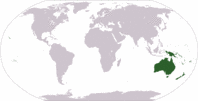Sommieria leucophylla
| Sommieria (sohm-MEHR-ee-uh) leucophylla (lou-koh-FILL-uh) | |||||||
|---|---|---|---|---|---|---|---|
 Andai Manokwari, West Papua, Indonesia. Photo by Dr. John Dransfield, Royal Botanic Gardens, Kew/Palmweb. | |||||||
| Scientific Classification | |||||||
| |||||||
| Synonyms | |||||||
|
| |||||||
| Native Continent | |||||||
|
| |||||||
| Morphology | |||||||
| |||||||
| Culture | |||||||
|
| |||||||
| Survivability index | |||||||
|
| |||||||
| Common names | |||||||
|
| |||||||
Habitat and Distribution
Sommieria leucophylla is endemic to IndonesianDescription
An attractive and rare understory palm with silver-backed leaves and a trunk attaining 3-4 meters (12 ft).
Solitary palm, slender, acaulescent to 3 m high. Stem 3 - 4 cm in diam., internodes short, to 1 cm, leaves up to 40 in the crown, without crownshaft. Leaves 92 - 180 x 12 - 30 cm; petiole 10 - 38.5 cm long, 4 - 16 mm wide and 3 - 8 mm thick at base, flat to channelled adaxially, rounded abaxially; sheaths 7 - 30 - 1 - 6.5 cm; rachis 40 - 115 cm long; spacing between segments 4 - 10 cm, 17 - 20 main veins in simple-bifid leaves, divided leaves with 9 - 10 main veins in bifid part and 4 - 6 main veins in basal segment. Inflorescence interfoliar, up to 160 cm long at anthesis; prophyll 16 - 46 x 1 - 2.5 cm, persistent; peduncle up to 136 cm long; peduncular bract 80 - 245 x 13 - 25 mm, 10 - 30 mm spacing to first rachillae; rachillae less than 20, branching to 1 order (sometimes branching to 2 orders at first rachillae), 11 - 27 cm long, 1 - 10 mm spacing between first to two rachillae. Staminate flowers c. 2.5 mm in diam.; sepals 1 - 1.5 x 2 - 2.5 mm, imbricate, semiorbicular to reniform, cream to light brown; petals 1.5- 2 x 2- 2.7 mm, ovate-triangular, cream to light brown; stamens 6; anthers 0.75 - 1 mm long; filaments 1.5 - 2 x 0.3 - 0.5 mm, inflexed in bud, sometimes twisted; pistillode 0.75 - 1 x 0.5 mm. Pistillate flowers 2.5 - 3 mm in diam.; sepals about 2 x c. 2.5 mm, semi orbicular to reniform, cream to light brown; petals about 2.5 x about 3 mm, triangular, cream to light brown; staminodes 0.5 - 0.75 x about 0.25 mm at the base. Fruits spherical to ellipsoidal, 1-seeded, 9 - 15 x 8 - 15 mm, corky-warty, dark brown and bright pink when ripe, fleshy and juicy. Seeds 5 - 9 x 5 - 8 x 4 - 7 mm, spherical to ellipsoidal; endosperm homogenous; embryo sub-basal. (Ch.D. Heatubun. 2002)/Palmweb. Editing by edric.
Beccari (1877, 1914) differentiated S. leucophylla from S. elegans on the colour of the leaves, leaf segmentation and the size of the inflorescence (more 'robust' in S. elegans) and then he differentiated S. affinis from S. leucophylla by its smaller size and by the fronds being doubly-toothed at the tips. Moore made an unpublished key in 1956 to separate the three species. In this key, Sommieria elegans is separated from the two other species based on leaves being large, long-petioled, dull but not pale below, and S. affinis from S. leucophylla based on the tips of the segments. Morphological plasticity that occurs in Sommieria displays gradual and often overlapping variation and this has influenced the species concept used in this revision, which is broader than that used by earlier authors. The narrow species concept used in the genus reflects limited information obtained from single collections. No disjunctions in variation occur that would allow the consistent separation of three species in Sommieria as recognised by Beccari and followed by other authors (e.g. Ferrero & Dowe 1994); the distinguishing characters used are almost all vegetative characters that, now that we have a good number of specimens, can be seen to display a wide range of variation. The shape and size of the fruits and seeds varies greatly within individuals and populations. Because of this, fruit and seed shape and size is not considered to be of value in the delimitation of species. Ferrero (1997) proposed new forms of S. affinis and S. leucophylla (without providing formal names), after looking at pictures and photographs and speculating that S. elegans is very different by being larger in all its dimensions (size of leaves, thickness of stem, length of peduncle, etc.). The decision in this study to recognise one species only, is based on detailed examination of all available herbarium specimens and careful observation in the field. (Ch.D. Heatubun. 2002)/Palmweb.
Culture
Coming from very dense, wet, and humid rain forest, the cultural requirements are obvious.
Comments and Curiosities
This is a monotypic genus.
- IMAGE GALLERY
Many Special Thanks to Ed Vaile for his long hours of tireless editing and numerous contributions.




























